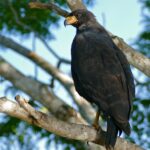Great Black Hawks (Buteogallus urubitinga) are birds of prey that are typically solitary and are not known to form large groups like some other bird species. However, they do form temporary groups during hunting, particularly when searching for food in a neighborhood.
Do Great Black Hawks Form Temporary Groups?
Yes, Great Black Hawks do form temporary groups, but these groups are not permanent. They are often observed forming “kettles” when riding thermals, which are rising columns of warm air that allow them to soar with minimal effort.
When hawks form these temporary groups, they are able to gain altitude and search for food from above, making it an efficient hunting strategy. This behavior is not exclusive to Great Black Hawks and is observed in many other raptor species, including vultures and eagles.
Do Great Black Hawks Form Families During Breeding Season?
 Image source: Great Black Hawk by Bernard DUPONT
Image source: Great Black Hawk by Bernard DUPONT
While Great Black Hawks are known to be solitary birds, they do form families during the breeding season. During this time, it is not uncommon to see a mated pair of hawks and their offspring together. However, once the young hawks have fledged and become independent, they typically disperse and become solitary again.
Factors Influencing Great Black Hawks’ Grouping Behavior
There are several factors that can influence the grouping behavior of Great Black Hawks:
-
Hunting Strategies: As mentioned earlier, Great Black Hawks form temporary groups when riding thermals to gain altitude and search for food from above. This behavior is an efficient hunting strategy that allows them to cover a larger area and increase their chances of finding prey.
-
Breeding Season: During the breeding season, Great Black Hawks form families, with a mated pair and their offspring staying together until the young hawks become independent.
-
Environmental Conditions: The availability of food and other resources in a particular area can also influence the grouping behavior of Great Black Hawks. If food is scarce, they may be more likely to form temporary groups to increase their chances of finding prey.
-
Predator Avoidance: Forming temporary groups can also help Great Black Hawks avoid predators, as they can more easily spot and evade threats when they are in a group.
Comparison with Other Raptor Species
While Great Black Hawks are not known to form large, permanent groups, their grouping behavior is similar to that of other raptor species. Many other birds of prey, such as vultures and eagles, also form temporary groups when riding thermals or searching for food.
For example, Turkey Vultures (Cathartes aura) are often observed circling in groups, known as “kettles,” as they use thermals to gain altitude and search for carrion. Similarly, Bald Eagles (Haliaeetus leucocephalus) have been observed forming temporary groups when hunting for fish or scavenging for food.
Conclusion
In summary, while Great Black Hawks are typically solitary birds, they do form temporary groups during hunting, particularly when riding thermals to gain altitude and search for food. This behavior is not exclusive to Great Black Hawks and is observed in many other raptor species. Additionally, Great Black Hawks form families during the breeding season, with a mated pair and their offspring staying together until the young hawks become independent.

